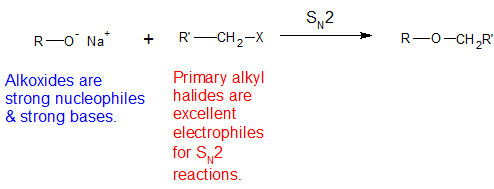15.3: The Williamson Ether Synthesis
- Page ID
- 45527
One important procedure, known as the Williamson Ether Synthesis, proceeds by an SN2 reaction of an alkoxide nucleophile with an alkyl halide. There are four reaction pathways possible between an alkoxide and alkyl halide: SN2, SN1, E2, and E1. To maximize the amount of ether produced by the SN2 mechanism, use a 1º alkyl halide as the electrophile because the strong alkoxide base leads to E2 elimination with 2º and 3º alkyl halides.

The reactions below show how alkoxide and alkyl halide structure can influence the products when applied to an unsymmetrical ether. Two different combinations of reactants are possible. Of these one is usually better than the other for ether synthesis. The first reaction gives a better and cleaner yield of benzyl isopropyl ether, while the second reaction generates considerable elimination product.

Exercises
3. When preparing ethers using the Williamson ether synthesis, what factors are important when considering the nucleophile and the electrophile?
4. How would you synthesize the following ethers? Keep in mind there are multiple ways. The Williamson ether synthesis, alkoxymercuration of alkenes, and also the acid catalyzed substitution.
(a) (b)
(c)
(d)
(e)
5. Draw the electron arrow pushing mechanism for the formation of diethyl ether in the previous problem.
- Answer
-
3. The nucleophile ideally should be very basic, yet not sterically hindered. This will minimize any elimination reactions. The electrophile should have the characteristics of a good SN2 electrophile, preferably primary to minimize any elimination reactions.
4. The Williamson ether syntheses require added catalytic base. Also, most of the halides can be interchanged, say for example for a -Br or a -Cl. Although, typically -I is the best leaving group.
(a)
(b)
(c)
(d)
Note, there is only one ether (also called a silyl ether, and often used as an alcohol protecting group.) The other group is an ester.
(e)
5.

